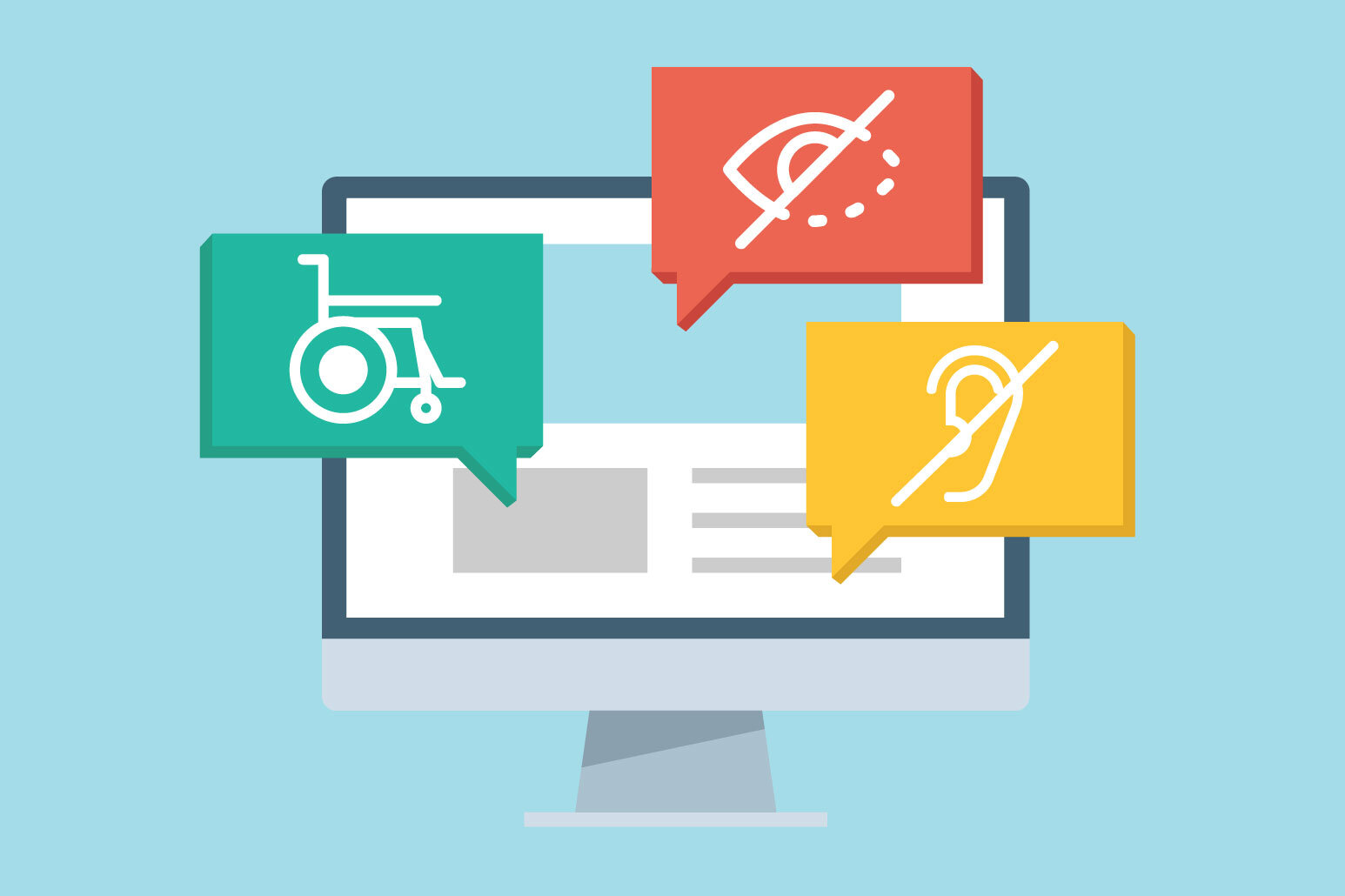Most people have not heard of ADA compliance or don’t care because they feel it doesn’t apply to their business but now more than ever ADA compliance is hitting all businesses hard. There are more ADA lawsuits coming out this past year compared to ever before. This is because people with disabilities and lawyers are starting to understand how they can use this law to their advantage. 2019 was a record-breaking year for Federal ADA Title III lawsuits with 11,053 ADA lawsuits in federal court which were 8.8% more compared to the previous year.
If you are trying to figure out if your website needs to be ADA compliant, I will make it easy for you to understand:
In the United States, under the Americans with Disabilities Act (ADA) all websites need to be accessible.
That includes websites that do not sell goods or services. Now You might be thinking, yeah but what are the odds of me getting sued for not being ADA compliant. That is an unknown, but the probabilities get higher every year. I knew someone that had a small business that was barely making any money that got sued for ADA compliance. With ADA compliance cases they are usually open and close cases which means it is easy to see if the website is ADA compliant or not. They had to pay a $50,000 settlement, which they did not have the money for, and it made their business go under. This could happen to anyone and it is a nightmare when it happens.
What is ADA Compliance:
In September 2010, the U.S. Department of Justice (DOJ) published the Standards of Accessible Design, an update to the ADA that was first passed in 1990. These standards apply to commercial and public entities that have"places of public accommodation".
The law applies to:
Americans with disabilities and their friends, families, and caregivers
Private employers with 15 or more workers
All local and state government agencies (which comprises both physical and programmatic access to all programs and services provided )
Businesses operating for the sake of the General Public and non-profits (more specifically, "public accommodations and commercial facilities")
The interpretation to add sites is the result of recent suits at which "public lodging " has been extended to comprise non-physical locations, such as sites. With this addition, the ADA has made it crystal clear that we have to attain the same degree of availability online that handicapped men and women are ensured by law off.
What's not clear is exactly what the ADA believes as accessible site articles for "public accommodation." In April 2016, the DOJ did openly seek out advice on technical internet standards (in what we hoped would result in their stance on web accessibility guidelines). Unfortunately, on December 22, 2017, the DOJ withdrew any impending rulemaking as it pertains to web availability.
Authority on ADA Compliance Guidelines - W3C
There are many websites that claim they give credible guidelines to follow for ADA compliance but there is only one authority to this in my opinion and that is W3C. Web Content Accessibility Guidelines (WCAG) is developed through the W3C process in cooperation with individuals and organizations around the world, with a goal of providing a single shared standard for web content accessibility that meets the needs of individuals, organizations, and governments internationally.
The WCAG documents explain how to make web content more accessible to people with disabilities. Web “content” generally refers to the information in a web page or web application, including:
natural information such as text, images, and sounds
code or markup that defines the structure, presentation, etc.
The WCAG 2.1 guidelines ensure your web content is:
Perceivable: Content is presented in an easily perceivable manner. Examples include offering alternatives to text, such as audio alternatives or assistive technology, that allow sight-impaired individuals to perceive your website's content.
Operable: Navigation is easy to operate. Examples include offering keyboard accessibilities so users with disabilities can easily navigate your website and access content.
Understandable: Content is easy to understand. Examples include making content readable and predictable, and offering input assistance if needed.
Robust: Your website's content can be interpreted by various devices and platforms. For example, you want to ensure content is compatible with user agents like assistive technologies.
Common Website Fixes for ADA Compliance
Enhancing the accessibility of your business's site to those that are visually impaired, hearing impaired, or those who must navigate by audio can be done in multiple ways, including some which are not immediately obvious.
For example, if someone is sight impaired, the web designer can install certain technology, such as screen readers, in which a voice reads the text onto the screen back to the internet visitor. Refreshable Braille text for touchscreens may likewise be utilized.
Instead of any regulatory guidance, business owners should look to regulations that govern federal agencies' websites and relevant case law to gain an understanding of exactly what compliance may be.
"There is no regulatory guidance on this issue -- nonetheless -- for industrial entities," said Nancy Del Pizzo, a partner in the law firm Rivkin Radler. "Thus, there are no exemptions or regulations that specify 'ADA compliance' regarding sites. There are, however, requirements for federal sites, in addition to some detailed legal decisions which may be used as guidance, including opinions which have held that 'reasonable' accessibility is essential."
Here are some common ways businesses can address availability issues associated with their Internet content:
Produce alt tags for all images, videos, and audio files. Alt tags allow users with disabilities to read or listen to alternative descriptions of content that they might not otherwise be able to view. Alt tags explain the thing itself and, normally, the purpose it functions on the site.
Create text transcripts for video and audio content. Text transcripts help hearing-impaired users understand the content that could otherwise be inaccessible to them. Which makes it clear what language the site ought to be read in assists users that utilize text readers. Text readers may determine those codes and function so.
Offer alternatives and suggestions when users encounter input mistakes. If a person with a disability is encountering input errors due to their need to navigate the website otherwise, your website should automatically offer recommendations regarding how visitors can better navigate into the information they require.
Produce a consistent, organized design. Menus, buttons, and links must be organized in such a manner that they are clearly delineated from one another and are easily navigated throughout the whole site.
There are other ways companies can create an accessible website for consumers with disabilities. Consulting with a lawyer who specializes in disability law is a must for businesses concerned about ADA compliance, but if you're trying to find somewhere to get started by yourself, reading the ADA requirements is an important first step.
The common ways stated above to help make your website ADA compliant does not mean that your website meets the ADA standards. These are low hanging fruit that you can add to your website to help make it more ADA accessible but you will need an ADA website development expert to make sure your website is fully accessible for the below disabilities:
Seizures
Blind or Visually Impaired
Cognitive Disability
ADHD
Deaf or Hearing Impaired
Epilepsy
Easy ADA Website Layering Tool for Businesses
Recently I have been using an AI-powered net accessibility tool known as accessiBe and that I can honestly say it is an all-in-one tool to aid with ADA compliance. It does not correct all of your ADA accessibility issues on your site, but it will make it so a person with a handicap can navigate your website without too much of a problem. Reachable can be easily added to any site's header with a JavaScript code that will update all your pages using an accessibility button and layer
By combining two different applications that work Simultaneously, an accessibility interface and AI processes, accessiBe achieves and maintains the highest level of compliance - WCAG 2.1 guidelines in the AA degree.
The accessiBe Interface
The accessiBe interface is responsible for remediating 30 percent of the accessibility barriers websites typically face. The port is a session-based tool that lets users make certain adjustments to the look of the website, which allows users with visual impairments, epilepsy, cognitive disabilities, and many others to easily get the info on any website. Our interface includes dozens of unique alternatives, so every user can tailor the site to match their distinctive handicap.
accessiBe AI Processes
Display reader optimization and keyboard navigation Adjustments, which constitute the remaining 70% of the WCAG requirements, are two Of the greatest challenges to web accessibility. To mend them, accessiBe utilizes a combination of contextual understanding and computer vision technologies. AccessiBe's AI analyzes the components of a website, determines their performance, and automatically adjusts them according to the WCAG 2.1 AA requirements.
accessiBe Integration
The accessibe integration process is easy and it can be used on many different CMS platforms. Once you have signed up for the yearly or monthly subscription you can add an accessiBe javascript code to the global header of the website. This can be done in many ways such as injecting the code, adding it in a plugin for WordPress, or putting custom code into Google Tag Manager. For more details on accessiBe integration please go here. Once the code is added there is nothing more you need to do. The code will go into each page and you will see the accessibility icon on the bottom right or left of your website for desktop and mobile. This is a perfect solution for small businesses that don’t have the time or money for an expensive accessibility web developer.
In Conclusion
Making your website ADA compliance is a complex issue and most websites would not pass an ADA audit. However, ADA is a requirement now and most agencies will not do a website unless the client agrees to make it ADA accessible. Making your website ADA accessible really has to routes to it, you can take the first route with is manually making your website ADA compliant which will need a tech person with ADA expertise to help with.
The second option if you have a small website that is not customized is you can get an ADA tool to add to your website for a yearly or monthly fee. But not making your website ADA compliant is not an option. In fact, it is a slap in the face to anyone with a disability if your website is not ADA compliant. So do your part to make the internet more accessible for people with disabilities and make this a priority for your business.





